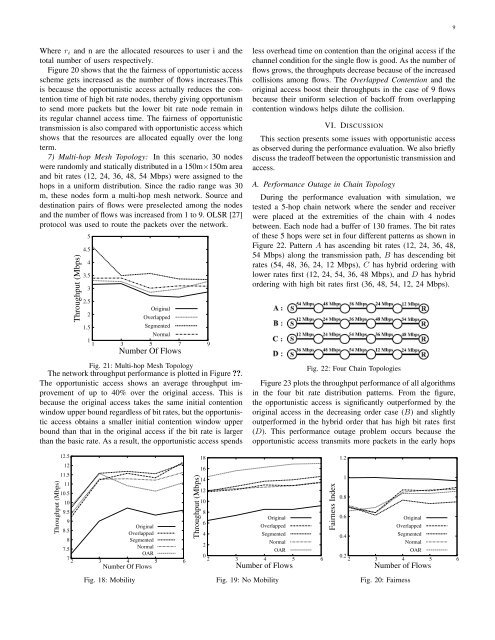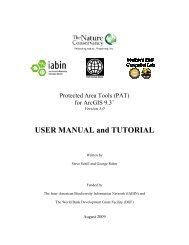Tech Report - University of Virginia
Tech Report - University of Virginia
Tech Report - University of Virginia
Create successful ePaper yourself
Turn your PDF publications into a flip-book with our unique Google optimized e-Paper software.
9Where r i and n are the allocated resources to user i and thetotal number <strong>of</strong> users respectively.Figure 20 shows that the the fairness <strong>of</strong> opportunistic accessscheme gets increased as the number <strong>of</strong> flows increases.Thisis because the opportunistic access actually reduces the contentiontime <strong>of</strong> high bit rate nodes, thereby giving opportunismto send more packets but the lower bit rate node remain inits regular channel access time. The fairness <strong>of</strong> opportunistictransmission is also compared with opportunistic access whichshows that the resources are allocated equally over the longterm.7) Multi-hop Mesh Topology: In this scenario, 30 nodeswere randomly and statically distributed in a 150m×150m areaand bit rates (12, 24, 36, 48, 54 Mbps) were assigned to thehops in a uniform distribution. Since the radio range was 30m, these nodes form a multi-hop mesh network. Source anddestination pairs <strong>of</strong> flows were preselected among the nodesand the number <strong>of</strong> flows was increased from 1 to 9. OLSR [27]protocol was used to route the packets over the network.Throughput (Mbps)54.543.532.52OriginalOverlapped1.5SegmentedNormal11 3 5 7 9Number Of FlowsFig. 21: Multi-hop Mesh TopologyThe network throughput performance is plotted in Figure ??.The opportunistic access shows an average throughput improvement<strong>of</strong> up to 40% over the original access. This isbecause the original access takes the same initial contentionwindow upper bound regardless <strong>of</strong> bit rates, but the opportunisticaccess obtains a smaller initial contention window upperbound than that in the original access if the bit rate is largerthan the basic rate. As a result, the opportunistic access spendsless overhead time on contention than the original access if thechannel condition for the single flow is good. As the number <strong>of</strong>flows grows, the throughputs decrease because <strong>of</strong> the increasedcollisions among flows. The Overlapped Contention and theoriginal access boost their throughputs in the case <strong>of</strong> 9 flowsbecause their uniform selection <strong>of</strong> back<strong>of</strong>f from overlappingcontention windows helps dilute the collision.VI. DISCUSSIONThis section presents some issues with opportunistic accessas observed during the performance evaluation. We also brieflydiscuss the trade<strong>of</strong>f between the opportunistic transmission andaccess.A. Performance Outage in Chain TopologyDuring the performance evaluation with simulation, wetested a 5-hop chain network where the sender and receiverwere placed at the extremities <strong>of</strong> the chain with 4 nodesbetween. Each node had a buffer <strong>of</strong> 130 frames. The bit rates<strong>of</strong> these 5 hops were set in four different patterns as shown inFigure 22. Pattern A has ascending bit rates (12, 24, 36, 48,54 Mbps) along the transmission path, B has descending bitrates (54, 48, 36, 24, 12 Mbps), C has hybrid ordering withlower rates first (12, 24, 54, 36, 48 Mbps), and D has hybridordering with high bit rates first (36, 48, 54, 12, 24 Mbps).Fig. 22: Four Chain TopologiesFigure 23 plots the throughput performance <strong>of</strong> all algorithmsin the four bit rate distribution patterns. From the figure,the opportunistic access is significantly outperformed by theoriginal access in the decreasing order case (B) and slightlyoutperformed in the hybrid order that has high bit rates first(D). This performance outage problem occurs because theopportunistic access transmits more packets in the early hopsThroughput (Mbps)12.51211.51110.5109.598.5OriginalOverlapped8Segmented7.5NormalOAR72 3 4 5Number Of Flows6Fig. 18: MobilityThroughput (Mbps)1816141210864OriginalOverlappedSegmentedNormal2OAR02 3 4 5 6Number <strong>of</strong> FlowsFig. 19: No MobilityFairness Index1.210.80.60.4OriginalOverlappedSegmentedNormalOAR0.22 3 4 5 6Number <strong>of</strong> FlowsFig. 20: Fairness
















